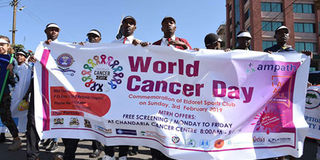To defeat cancer, throw more resources at it

Uasin Gishu residents raise awareness of cancer, in Eldoret town on February 3, 2019. The response to the disease by the government and the society is inadequate. PHOTO | JARED NYATAYA | NATION MEDIA GROUP
What you need to know:
- With increased awareness, free screening, early diagnosis and treatment, its impact can reduce significantly.
- The national budget should allocate adequate resources to recruitment, remuneration and retention of all medical personnel in public facilities.
Cancer not only robs the affected person of their health, but also dignity and resources.
The World Health Organisation (WHO) ranks the killer disease as the second leading cause of death, responsible for more deaths than HIV, tuberculosis (TB) and malaria combined.
But there is hope: 30-50 percent of cancers are preventable and treatable if detected early.
My own encounter with cancer happened eight years ago. My mother was diagnosed with cervical cancer on May 2, 2010, and, exactly a year later, on May 2, 2011, she passed on.
She was only 51, in her prime with several goals and milestones still unachieved. My mother exhibited no symptoms until it was much too late to save her.
After two surgeries, chemo- and radio therapy, all we could do was give palliative care.
DIAGNOSIS
After a few months of treatment her medical insurance cover ran out. We experienced the high cost of treating the disease locally.
Health ministry data shows it is the third-highest cause of mortality after infectious and cardiovascular diseases. It kills 90 people daily, or seven percent of all deaths yearly, 60 percent of patients under 70.
Sadly, 70-80 percent of cases are diagnosed in the late stages — mainly for lack of awareness, inadequate diagnostic and treatment facilities vis-à-vis the population and high cost of screening for most Kenyans.
With increased awareness, free screening, early diagnosis and treatment, its impact can reduce significantly. If Kenya is serious about reducing the impact and prevalence of cancer, we should adopt a three-pronged approach.
NATIONAL DISASTER
Declare the disease a national disaster and give its prevention, screening and treatment the same attention and resources as HIV and Aids in the late 1990s.
Some 20 years ago, in November 1999, then-President Daniel arap Moi declared the HIV/Aids epidemic a national disaster and created the National Aids Control Council.
Aids education would be introduced in all schools and colleges that January. It is difficult to visualise the magnitude of the scourge.
It is not like a terrorist attack, where the effects can immediately be seen and felt, but that does not make it any less a disaster.
The response to the disease by the government and the society is inadequate. We need a national agency to lead concerted efforts towards prevention and control.
MEDICINES
It would rally stakeholders and have consistent public campaigns, oversee free screening and testing in public health facilities and ease access to treatment, besides conducting research.
The national budget should allocate adequate resources to recruitment, remuneration and retention of all medical personnel in public facilities.
Manufacture generic drugs locally and zero-rate imported medical equipment and diagnostic tools to make them more affordable and accessible.
The proposed Kenya Food and Drugs Authority would regulate medicine and food safety and quality.
According to the WHO, about a third of cancer deaths are due to behavioural and dietary risk factors. We should regulate the use of farm chemicals better.
If all these recommendations are implemented, we will see a marked reduction in the prevalence and impact of cancer over the next 10 years.
Ms Taa is a fashion designer and commentator on governance, based in Nairobi. [email protected]




